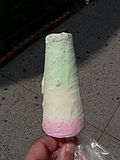Kulfi: Difference between revisions
CSV import Tags: mobile edit mobile web edit |
CSV import |
||
| Line 27: | Line 27: | ||
[[Category:Ice cream]] | [[Category:Ice cream]] | ||
{{food-stub}} | {{food-stub}} | ||
<gallery> | |||
File:Kesari_Aam_Kulfi_01.jpg|Kesari Aam Kulfi | |||
File:Strawbeerry_kulfi.JPG|Strawberry Kulfi | |||
File:Kulfi.jpg|Kulfi | |||
File:Kulfi_Faluda.jpg|Kulfi Faluda | |||
File:Kulfi_(1).jpg|Kulfi | |||
</gallery> | |||
Latest revision as of 04:51, 18 February 2025
Kulfi is a popular frozen dessert originating from the Indian subcontinent. It is often described as the South Asian variant of ice cream. Unlike Western ice cream, kulfi is not whipped, resulting in a solid, dense frozen dessert similar to traditional custard based ice cream.
History[edit]
The origin of kulfi is traced back to the Mughal Empire in the 16th century. It was a popular dessert among the royal families. The dessert was traditionally prepared by evaporating sweetened and flavored milk over a slow fire, then freezing the mixture in small, cone-shaped molds.
Preparation[edit]
The traditional method of preparing kulfi involves boiling milk until it reduces to half its volume, to achieve a thick, creamy consistency. Sugar, cardamom, and other flavorings such as saffron, pistachio, and rose water are added to the reduced milk. The mixture is then poured into molds and frozen until set.
Varieties[edit]
There are several varieties of kulfi, including malai (cream), pista (pistachio), rose, mango, cardamom, saffron, and more. Each variety has a unique flavor profile and color. For example, saffron kulfi has a distinct yellow color and a rich, aromatic flavor.
Consumption[edit]
Kulfi is commonly served at festivals and celebrations across the Indian subcontinent and is also popular in the Middle East. It is often served on a stick for easy consumption, similar to an ice cream cone, but can also be served in a dish with a spoon.
See Also[edit]
-
Kesari Aam Kulfi
-
Strawberry Kulfi
-
Kulfi
-
Kulfi Faluda
-
Kulfi





